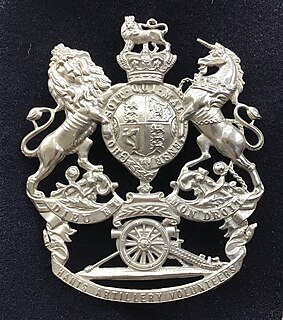
The 2nd Devonshire Artillery Volunteers was a unit of the British Volunteer Force and Territorial Army. The unit and its successors defended Plymouth Dockyard and the Devon coast from 1861 to 1961.
The 1st Kent Artillery Volunteers was a part-time unit of the British Army's Royal Artillery from 1860 to 1956. Primarily serving as coastal artillery defending the Port of Dover and other harbours in South-East England, the unit's successors also served in the heavy artillery role on the Western Front during World War I and as anti-aircraft artillery during the Blitz and later in the North African and Italian campaigns of World War II.
The 1st Cinque Ports Artillery Volunteers was a part-time unit of the British Army's Royal Artillery from 1860 to 1956. Raised as coastal defence artillery, the unit later served as field artillery in Mesopotamia during World War I, and as anti-aircraft artillery during the Blitz and in the Middle East during World War II.

The 2nd Cinque Ports Artillery Volunteers was a part-time unit of the British Army's Royal Artillery from 1890 to 1955. Raised as coastal defence artillery, it later served as field artillery in Mesopotamia during the First World War and in the Battle of France and Second Battle of El Alamein during the Second World War. Its successor units later operated as medium artillery in North West Europe, and as jungle artillery in Burma. Postwar, it became an anti-aircraft unit.

The 1st Sussex Artillery Volunteers was a part-time unit of the British Army's Royal Artillery from 1859 to 1961. Raised as coastal defence artillery, the unit later served as field artillery in Mesopotamia during the First World War, and in North Africa, Sicily, Italy and North West Europe during the Second World War. It carried out a number of roles in the postwar Territorial Army.

The 1st East Yorkshire Artillery Volunteers was a part-time unit of Britain's Royal Artillery based in the East Riding of Yorkshire, which also contained sub-units from the North and West Ridings. Created during an invasion scare in 1859–1860, it survived to supply units to the later Territorial Force of the 20th century.

The 1st Hampshire Artillery Volunteers and its successors were part-time coast defence units of the British Army from 1860 to 1967. Although the units saw no action, they protected the Portsmouth area in both World Wars and supplied trained gunners to siege batteries engaged on the Western Front during World War I. The unit continued in the Territorial Army after World War II.

The 1st Lancashire Artillery Volunteers, popularly known as 'Brown's Corps', was an auxiliary unit of the British Army raised in Liverpool in 1859. As the Lancashire & Cheshire Royal Garrison Artillery in the Territorial Force it was responsible for defending the Mersey Estuary and the coastline of North West England. It was one of the few coast defence units to fire a shot during World War I but also provided personnel for a number of siege batteries that saw action on the Western Front. It continued in the coast defence role during World War II, at the end of which it sent troops to work in the rear areas in Europe. It was reformed postwar but was broken up when the coast artillery branch was abolished in 1956.

The Northern Division, Royal Artillery, was an administrative grouping of garrison units of the Royal Artillery, Artillery Militia and Artillery Volunteers within the British Army's Northern District from 1882 to 1889.

The Lancashire Division, Royal Artillery, was an administrative grouping of garrison units of the Royal Artillery, Artillery Militia and Artillery Volunteers within the British Army's Northern District from 1882 to 1889.

The London Division, Royal Artillery, was an administrative grouping of garrison units of the Royal Artillery and Artillery Volunteers within the British Army's Home and Woolwich Districts from 1882 to 1889.

The Scottish Division, Royal Artillery, was an administrative grouping of garrison units of the Royal Artillery, Artillery Militia and Artillery Volunteers within the British Army's Scottish District from 1882 to 1889.

The Welsh Division, Royal Artillery, was an administrative grouping of garrison units of the Royal Artillery, Artillery Militia and Artillery Volunteers in the British Army's Western District from 1882 to 1889.

The North Irish Division, Royal Artillery, was an administrative grouping of garrison units of the Royal Artillery and Artillery Militia in Ireland from 1882 to 1889.

The South Irish Division, Royal Artillery, was an administrative grouping of garrison units of the Royal Artillery and Artillery Militia in Ireland from 1882 to 1889.

The Eastern Division, Royal Artillery, was an administrative grouping of garrison units of the Royal Artillery, Artillery Militia and Artillery Volunteers within the British Army's Eastern District from 1882 to 1902.

The Southern Division, Royal Artillery, was an administrative grouping of garrison units of the Royal Artillery, Artillery Militia and Artillery Volunteers within the British Army's Southern District from 1882 to 1902.

The 'Western Division, Royal Artillery,' was an administrative grouping of garrison units of the Royal Artillery, Artillery Militia and Artillery Volunteers within the British Army's Western District from 1882 to 1902.

The Mountain Division, Royal Artillery, was an administrative grouping of mountain artillery units of the Royal Artillery from 1889. It continued as a distinct branch of the Royal Garrison Artillery until World War I.






